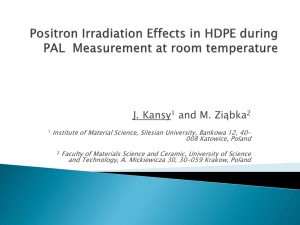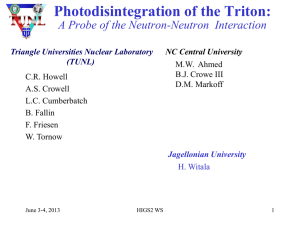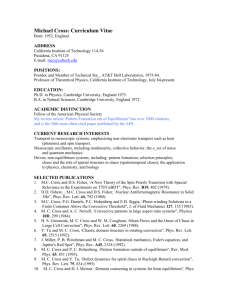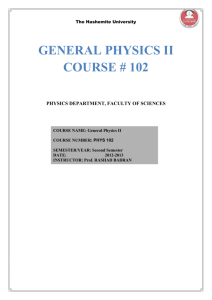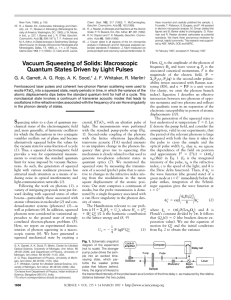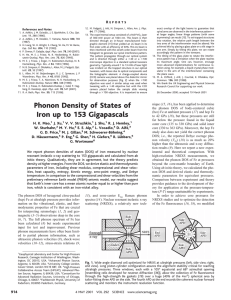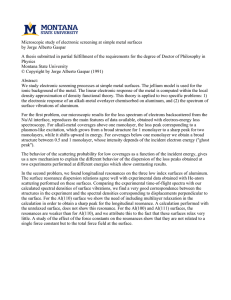Single atom of interstitial impurity
advertisement
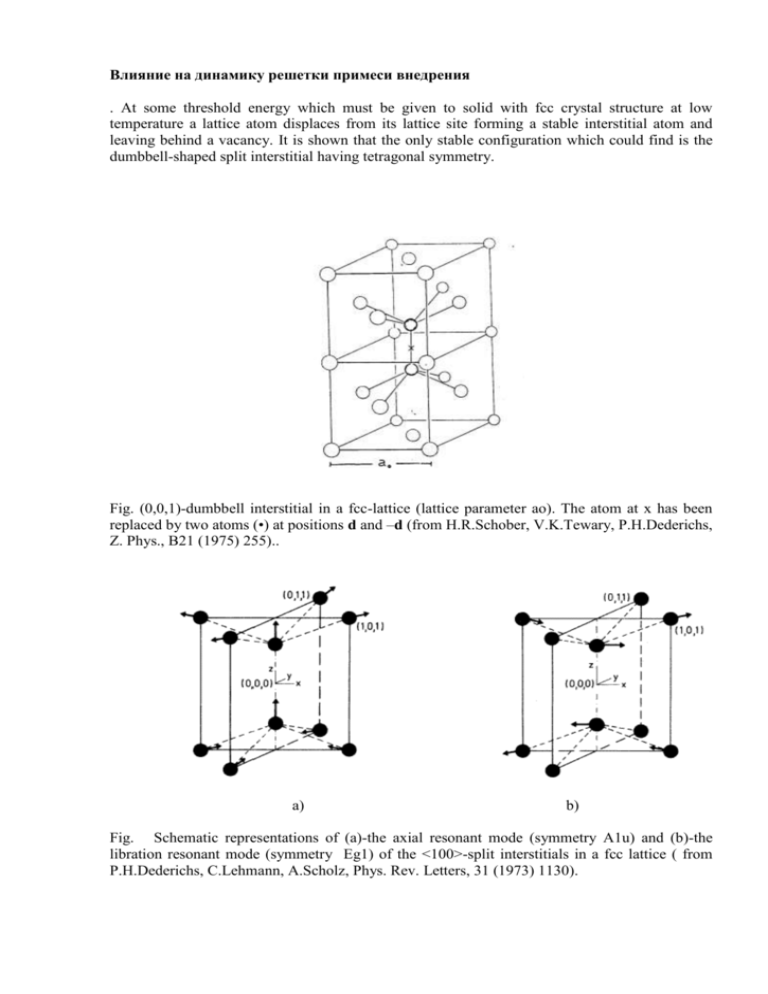
Влияние на динамику решетки примеси внедрения . At some threshold energy which must be given to solid with fcc crystal structure at low temperature a lattice atom displaces from its lattice site forming a stable interstitial atom and leaving behind a vacancy. It is shown that the only stable configuration which could find is the dumbbell-shaped split interstitial having tetragonal symmetry. Fig. (0,0,1)-dumbbell interstitial in a fcc-lattice (lattice parameter ao). The atom at x has been replaced by two atoms (•) at positions d and –d (from H.R.Schober, V.K.Tewary, P.H.Dederichs, Z. Phys., B21 (1975) 255).. a) b) Fig. Schematic representations of (a)-the axial resonant mode (symmetry A1u) and (b)-the libration resonant mode (symmetry Eg1) of the <100>-split interstitials in a fcc lattice ( from P.H.Dederichs, C.Lehmann, A.Scholz, Phys. Rev. Letters, 31 (1973) 1130). Cu, lattice – fcc The phonon dispersion curves of copper. Barry L.Fielek, J.Phys. F: Metal Phys. 5 (1975) 1451-1454. Fig. Phonon dispersion curves along symmetric directions for copper. The broken curve is with the Thomas-Fermi screening parameter and the solid curve is with the Bohm-Pines value. Neutron-scattering measurements of phonon perturbations in irradiated copper. R.M.Nicklow, W.P.Crummett, and J.M.Williams, Phys. Rev. B 20 (1979) 5034-5043. Fig. Schematic illustration of the hybridization between phonons and the librational modes of dumbbell interstitials. Fig. The frequency distributions of neutrons scattered from irradiated copper at 4 K for q=(0, 0, ζ)2π/a. The most obvious phononperturbation effects are the unusual peak structures observed for phonon wave vectors with ζ≤0.07. In this wave-vector region. The peaks appear to consist of two components. One is a relatively narrow peak located at a frequency which is very close to that for unirradiated copper. The second component occurs only on the high-frequency side of the scattering distributions and its intensity decreases with increasing ζ, becoming unobservably small for ζ≥0.08. Fig. The phonon peak shapes measured for irradiated and annealed copper for ζ=0.05. a) b) Fig. The phonon peak shapes measured for irradiated and annealed copper for (a) ζ=0.06 and (b) ζ =0.07. Fig. The phonon frequency shifts for irradiated copper. νirr and ν72 are the frequencies measured after the irradiation and after an anneal at 72 K. The full line shown is a guide to the eye and does not represent a theoretical calculation. The dashed line represents an extrapolation of elastic-constant data ( J.Holder, A.V.Granato, L.E.Rehn, Phys. Rev. Lett. 32 (1974) 1054; Phys. Rev. B 10 (1974) 363) Fig. The relative intensities of the second (high-frequency) peaks observed in the frequency distribution of neutrons of neutrons scattered from irradiated copper. Fig. The dispersion relation for the second (high-frequency) peaks observed in the frequency distribution of neutrons scattered from irradiated copper. The resolution function and the dispersion relation for the main phonon peak after the 72 K anneal are shown. Inelastic Neutron scattering Measurements of Phonon Dispersion Curves in reactor-Irradiated Aluminum at 4.6 K. K.Boning, G.S.Bauer, H.J.Fenzl, R.Scherm, H.J.Kaiser, Phys. Rev. Letters, 38 (1977) 852-855. Irradiation of a metal with fast particles produces Frenkel defects (FD), i.e., self-interstitials and vacancies, which are stable only at low temperatures. In aluminum, the interstitials become mobile at about 20 K and at room temperature all FD have annealed. Experimentally, it has been shown that for both Al and Cu the stable configuration of the interstitial is the [100] “split” (dumbbell) configuration (P.Ehrhart, H.G.Haubold, W.Schilling, Adv. Solid State Phys., 14 (1974) 87). Recent theoretical work predicts low frequency resonant vibrations (in addition to the high-frequency localized vibrations) for these interstitials (P.H Dederichs, C.Lehmann, A.Scholz, Phys. Rev. Lett., 31 (1973) 1130). Out of these vibrations, the coupling of the resonant libration modes to an applied [100] shear stress could explain the exceptionally large lattice softening found experimentally (P.H.Dederichs, C.Lehmann, A.Scholz, Z.Phys. B20 (1975) 155; K.H.Robrock, W.Schilling, J.Phys. F 6 (1976) 303). On the basis of the coupling of the dumbbell librations to the phonons, resonant perturbations of the [100] transverse dispersion curve have been predicted (H.R.Schober, V.K.Tewary, P.H.Dederichs, Z.Phys. B21 (1975) 255; R.F.Wood, M.Mostoller, Phys. Rev. Lett., 35 (1975) 45). The irradiation was performed at 4.6 K in the low temperature irradiation facility of the reactor Munich (H.Meissner, W.Schilling, H.Wenzl, Euronuclear, 2 (1965) 277 ). In a fast-neutron flux of about 1.4×1013 cm-2s-1 (E>0.1 MeV). The concentration of the defects could be monitored by measuring the resistivity of an Al wire attached to the sample. After thirty-two hours of irradiation the increase of residual resistivity was Δρ=324 nΩ cm corresponding to a FD concentration c=810 ppm. After a series of inelastic neutron scattering measurements at 4 K the sample was annealed for 30 min at 300 K. The reference measurements on the annealed sample were again carried out at 4 K. Fig. Two tipical scans (counting rate vs frequency measurements) at ζ=0.07 and 0.17, for the irradiated and for the annealed sample. Fig. Changes of the transverse (0, 0, ζ) phonon dispersion curve (irr=irradiated, ann=annealed). Circles, results of inelastic neutron scattering measurements. Squaares, experimental result derived from the changes of the elastic constant C44 (K.H.Robrock, W.Schilling, J.Phys. F 6 (1976) 303; L.E.Rehn, J.Holder. A.V.Granato, R.R.Coltman, F.W.Young, Phys. Rev. B 10 (1974) 349) and scaled to the indicated FD concentration. Dashed lines, theoretical prediction of the effect of isolated dumbshell interstitials (H.R.Schober, V.K.Tewary, P.H.Dederichs, Z.Phys. B21 (1975) 255), scaled to the indicated FD concentration. (a) Phonon frequency shift Δν/ν of Al after fast-neutron irradiation (c=810 ppm FD); (b) experimental line broadening ΔГ of Al after fast-neutron irradiation (c=810 ppm FD); (c) phonon frequency shift Δν/ν of Cu after thermalneutron irradiation (c=40 ppm FD) (R.Nicklow, R.R.Coltman, F.W.Young, R.F.Wood, Phys. Rev. Lett. 35 (1975) 1444).
